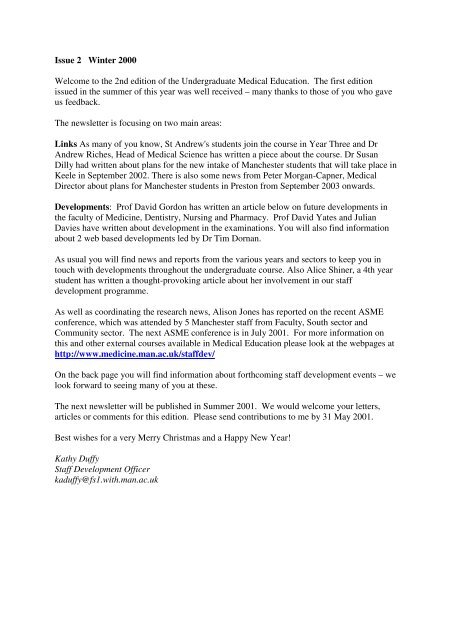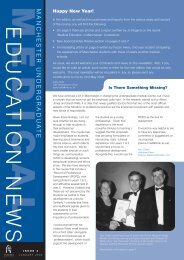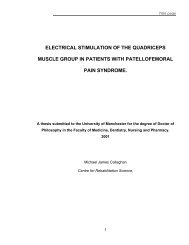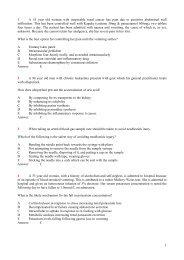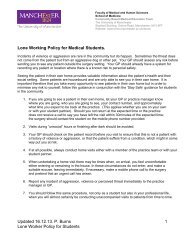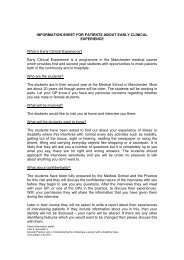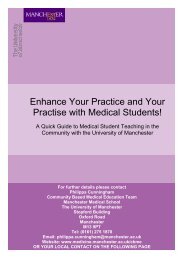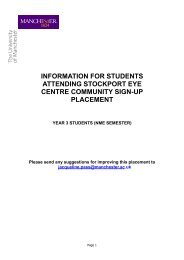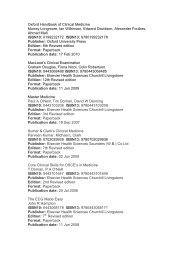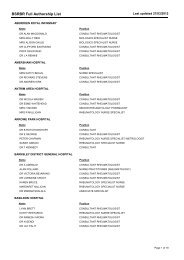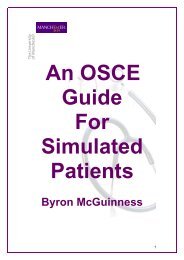Issue 2 Winter 2000 Welcome to the 2nd edition of the - School of ...
Issue 2 Winter 2000 Welcome to the 2nd edition of the - School of ...
Issue 2 Winter 2000 Welcome to the 2nd edition of the - School of ...
Create successful ePaper yourself
Turn your PDF publications into a flip-book with our unique Google optimized e-Paper software.
<strong>Issue</strong> 2 <strong>Winter</strong> <strong>2000</strong><strong>Welcome</strong> <strong>to</strong> <strong>the</strong> <strong>2nd</strong> <strong>edition</strong> <strong>of</strong> <strong>the</strong> Undergraduate Medical Education. The first <strong>edition</strong>issued in <strong>the</strong> summer <strong>of</strong> this year was well received – many thanks <strong>to</strong> those <strong>of</strong> you who gaveus feedback.The newsletter is focusing on two main areas:Links As many <strong>of</strong> you know, St Andrew's students join <strong>the</strong> course in Year Three and DrAndrew Riches, Head <strong>of</strong> Medical Science has written a piece about <strong>the</strong> course. Dr SusanDilly had written about plans for <strong>the</strong> new intake <strong>of</strong> Manchester students that will take place inKeele in September 2002. There is also some news from Peter Morgan-Capner, MedicalDirec<strong>to</strong>r about plans for Manchester students in Pres<strong>to</strong>n from September 2003 onwards.Developments: Pr<strong>of</strong> David Gordon has written an article below on future developments in<strong>the</strong> faculty <strong>of</strong> Medicine, Dentistry, Nursing and Pharmacy. Pr<strong>of</strong> David Yates and JulianDavies have written about development in <strong>the</strong> examinations. You will also find informationabout 2 web based developments led by Dr Tim Dornan.As usual you will find news and reports from <strong>the</strong> various years and sec<strong>to</strong>rs <strong>to</strong> keep you in<strong>to</strong>uch with developments throughout <strong>the</strong> undergraduate course. Also Alice Shiner, a 4th yearstudent has written a thought-provoking article about her involvement in our staffdevelopment programme.As well as coordinating <strong>the</strong> research news, Alison Jones has reported on <strong>the</strong> recent ASMEconference, which was attended by 5 Manchester staff from Faculty, South sec<strong>to</strong>r andCommunity sec<strong>to</strong>r. The next ASME conference is in July 2001. For more information onthis and o<strong>the</strong>r external courses available in Medical Education please look at <strong>the</strong> webpages athttp://www.medicine.man.ac.uk/staffdev/On <strong>the</strong> back page you will find information about forthcoming staff development events – welook forward <strong>to</strong> seeing many <strong>of</strong> you at <strong>the</strong>se.The next newsletter will be published in Summer 2001. We would welcome your letters,articles or comments for this <strong>edition</strong>. Please send contributions <strong>to</strong> me by 31 May 2001.Best wishes for a very Merry Christmas and a Happy New Year!Kathy DuffyStaff Development Officerkaduffy@fs1.with.man.ac.uk
GMC ReportLast time, I gave a brief summary <strong>of</strong> <strong>the</strong> Subject Review visit that was carried out in March.We still do not have <strong>the</strong> full report, so this will have <strong>to</strong> wait until a future newsletter. We dohave <strong>the</strong> full GMC report on <strong>the</strong> visit that was carried out at <strong>the</strong> same time. This was verypositive, as <strong>the</strong> summary statement makes clear:‘Although we have identified a number <strong>of</strong> areas for fur<strong>the</strong>r consideration we werevery impressed with <strong>the</strong> undergraduate medical education <strong>of</strong>fered in Manchester. Theexcellent relationship between students and staff has undoubtedly enabled <strong>the</strong> <strong>School</strong><strong>to</strong> develop its programme so rapidly. The <strong>School</strong> has successfully implemented a newand innovative course and all those involved, staff and students, deserve praise forwhat has been achieved. We look forward <strong>to</strong> hearing about fur<strong>the</strong>r progress in ayear’s time.’In <strong>the</strong> main report, <strong>the</strong>y GMC highlighted a number <strong>of</strong> areas <strong>of</strong> good practice:• The contribution <strong>of</strong> students• Learning through curiosity• Learning resources• The new ‘Fitness <strong>to</strong> Practise’ committee• Student support• Preparation for pre-registration yearHowever, <strong>the</strong>y also indicated areas for that we need <strong>to</strong> consider fur<strong>the</strong>r:• Clinical experience early in <strong>the</strong> course• Whe<strong>the</strong>r we should widen <strong>the</strong> options available in <strong>the</strong> special study modules in years 3-5<strong>to</strong> include <strong>to</strong>pics not directly related <strong>to</strong> medicine.• To consider advanced life support training for all final year students in <strong>the</strong> consolidationperiod• To include opportunities for students <strong>to</strong> learn about complementary and alternativemedicine in <strong>the</strong> core part <strong>of</strong> <strong>the</strong> course.These aspects <strong>of</strong> course development will be considered within a strategic plan, which alsoaddresses ways in which we can use <strong>the</strong> funding brought in by <strong>the</strong> additional student numbers<strong>to</strong> improve <strong>the</strong> programme for all students. We are also in <strong>the</strong> process <strong>of</strong> forming a medicaleducation unit that will bring <strong>to</strong>ge<strong>the</strong>r many important elements such as staff development,research & evaluation and communication skills teaching. As always, even with positiveexternal reports, we want <strong>to</strong> go on improving undergraduate medical education inManchester.Dr Paul O'NeillAssociate Dean for Medical Undergraduate Studies
NEWS FROM YEARS 1 & 2The new academic year and my stint as Direc<strong>to</strong>r <strong>of</strong> Studies began with <strong>the</strong> largest ever intakein<strong>to</strong> year 1 MB ChB. Approximately 325 first year students arrived on September 18 th .Earlier in <strong>the</strong> summer, new tu<strong>to</strong>rs recruited from <strong>School</strong> <strong>of</strong> Biological Sciences attended ashort training programme <strong>to</strong> introduce <strong>the</strong>m <strong>to</strong> <strong>the</strong> skills needed <strong>to</strong> direct group working. Theimmediate problem was <strong>to</strong> accommodate a <strong>to</strong>tal <strong>of</strong> 42 groups <strong>of</strong> MB ChB students meetingthree times a week for one-hour PBL sessions. The solution included a cluster <strong>of</strong> Portacabinsin <strong>the</strong> S<strong>to</strong>pford Building car park which have turned out <strong>to</strong> be surprisingly effective. I makethis judgement in <strong>the</strong> light <strong>of</strong> <strong>the</strong> small number <strong>of</strong> complaints from academic staff, and nonefrom <strong>the</strong> students. Meantime <strong>the</strong> building work on <strong>the</strong> new teaching block got underway andwe all keep our fingers crossed that it will be ready in time for <strong>the</strong> start <strong>of</strong> <strong>the</strong> 2001-2002session. Of course, <strong>the</strong> next session will entail a fur<strong>the</strong>r increase in student numbers so <strong>the</strong>new accommodation will earn its keep from day one.There was much additional spending over <strong>the</strong> summer. MB ChB students will benefit from<strong>the</strong> extensive refurbishment <strong>of</strong> <strong>the</strong> Dissection Room, which was completed before <strong>the</strong> start <strong>of</strong><strong>the</strong> new session. An even bigger refurbishment <strong>of</strong> <strong>the</strong> First Floor Multiuser Labora<strong>to</strong>ry waspartly finished when <strong>the</strong> students returned. We can accommodate extra students in bothlabora<strong>to</strong>ries.PHOTOI am particularly grateful <strong>to</strong> Keith Burdett for organizing <strong>the</strong> induction programme that wasdelivered <strong>to</strong> <strong>the</strong> freshers during <strong>the</strong> first week. O<strong>the</strong>rs, including Paul O’Neill and TimDornan, made large contributions <strong>to</strong> this important event. One <strong>of</strong> my problems is <strong>to</strong> work outhow we deliver <strong>the</strong> induction programme next year.What are <strong>the</strong> tasks ahead? The first is <strong>to</strong> bring in new staff, a problem that is being tackled byBiological Sciences. The need for new staff arises both from <strong>the</strong> extra intake <strong>of</strong> students, and<strong>the</strong> loss <strong>of</strong> some staff who have been involved in <strong>the</strong> new medical curriculum from <strong>the</strong> start.As well as Keith retiring, we have sadly lost David Evans, and o<strong>the</strong>rs are planning <strong>to</strong> retirethis year. Some aspects <strong>of</strong> <strong>the</strong> programme in <strong>the</strong> first two years need refreshing. We havemade a start. The IT course we are currently delivering is extensively revised compared <strong>to</strong>last year. The Design Teams that deliver <strong>the</strong> four semesters need more support. We mustrecruit some recently appointed staff <strong>to</strong> <strong>the</strong> teams. Continuing staff training that washighlighted by Keith in <strong>the</strong> previous <strong>edition</strong> <strong>of</strong> this Newsletter is a pressing need.Dr Paul SlaterDirec<strong>to</strong>r <strong>of</strong> Studies, Years 1&2
COMMUNITY NEWSIT Development for Education in <strong>the</strong> CommunityOver <strong>the</strong> last year Maria Regan has been evaluating <strong>the</strong> use <strong>of</strong> IT facilities by students onCommunity placements (see elsewhere in <strong>the</strong> Newsletter). She has worked with a smallnumber <strong>of</strong> practices that provide special facilities for students. These practices cover all threeyears and a broad geographical area. Questionnaires completed by 90 students and 21 GPTu<strong>to</strong>rs <strong>to</strong>ge<strong>the</strong>r with 42 longer interviews with students have helped us discover whatstudents and tu<strong>to</strong>rs need in both facilities and training.A by-product has been <strong>the</strong> writing <strong>of</strong> “An Internet-based Resource Guide for MedicalStudents and GP Tu<strong>to</strong>rs.” This is available in printed form and on disk. For fur<strong>the</strong>rinformation about this (or <strong>the</strong> Interim report) contact Maria Regan at Rusholme HealthCentre (0161 256 3015 ext.288 or m.regan@man.ac.uk).The next stageThe second stage will consider how students actually use <strong>the</strong> facilities available, how muchtime <strong>the</strong>y spend and what programmes or websites are useful. We are pleased that in doingthis we are able <strong>to</strong> collaborate with Project Connect, <strong>the</strong> NHS Information Authority’sprogramme <strong>to</strong> facilitate GP connections <strong>to</strong> NHSnet. They will help us determine <strong>the</strong>appropriate level <strong>of</strong> health authority input in<strong>to</strong> GP practice infrastructure and training <strong>to</strong>support undergraduate medical teaching. This will be done by working with an extra 12 Year5 practices.Where is this leading?On-line learning is becoming increasingly important, especially as students are spread far andwide in <strong>the</strong> Region. Students on community placement can use on-line resources <strong>to</strong> checkknowledge: that is easier than carrying around a textbook. They can access Medline <strong>to</strong> searchfor evidence. Soon <strong>the</strong>y will be able <strong>to</strong> use SkillsBase (produced by Tim Dornan and hiscolleagues) for self-assessment and <strong>to</strong> find advice on skills training. Above all <strong>the</strong>y can keepcontact with <strong>the</strong>ir base if <strong>the</strong> placement is at some distance and for some time (as in SSM’s orYear 5). It is hoped that as practices link up with <strong>the</strong> electronic world through NHSNet (orsimilar), <strong>the</strong>y will bear in mind <strong>the</strong> needs <strong>of</strong> students. We are now in a position <strong>to</strong> discussfacilities resources with <strong>the</strong> Regional Office.Carl WhitehousePr<strong>of</strong>essor <strong>of</strong> Teaching Medicine in <strong>the</strong> Community
Central Manchester ReportThe Central sec<strong>to</strong>r was pleased <strong>to</strong> welcome 136 new students <strong>to</strong> <strong>the</strong> third year in Oc<strong>to</strong>ber.A new Introduc<strong>to</strong>ry course for <strong>the</strong> third year was constructed and organised, largely by GuyNambiar. This was very well received by <strong>the</strong> students. The design <strong>of</strong> <strong>the</strong> course will continue<strong>to</strong> be revised year on year, and this first version was greatly enhanced by advice fromcolleagues from <strong>the</strong> South and Hope sec<strong>to</strong>rs.A particular success was <strong>the</strong> Communication skills part <strong>of</strong> <strong>the</strong> introduc<strong>to</strong>ry course, which wasalso new <strong>to</strong> Central this year. This required an enormous amount <strong>of</strong> work by RosieIllingworth and Carolyn Chew and <strong>the</strong>ir tu<strong>to</strong>rs, backed up by Mike Cheshire and <strong>the</strong> staff in<strong>the</strong> undergrad <strong>of</strong>fice. Their efforts were greatly appreciated by <strong>the</strong> students judged by <strong>the</strong>feed back received.An innovation which seems <strong>to</strong> be <strong>of</strong> some value was an inter-active seminar on “The role <strong>of</strong>religious Beliefs on Patients’ Needs”. This was lead by <strong>the</strong> Anglican and Jewish chaplains(unfortunately, <strong>the</strong> Moslem chaplain was unable <strong>to</strong> attend due <strong>to</strong> an emergency ). There was alively and wide ranging discussion involving colleagues <strong>of</strong> many different, and no, religiousbeliefs. This seminar will again evolve, hopefully with o<strong>the</strong>r religions involved, but shouldhave a useful role in future years.A fur<strong>the</strong>r change this year has been in <strong>the</strong> delivery <strong>of</strong> tuition <strong>to</strong> <strong>the</strong> final year. In addition <strong>to</strong><strong>the</strong>ir previous supervision and tu<strong>to</strong>rials <strong>the</strong> final year students at MRI have been invited <strong>to</strong>join <strong>the</strong> House <strong>of</strong>ficers’ teaching sessions each week. These sessions are a combination <strong>of</strong>didactic and interactive events usually lead by an expert. So far this arrangement has workedwell. There may be some merit in fur<strong>the</strong>r combined teaching/training sessions for final yearstudents and <strong>the</strong> House Officers. This approach is currently being examined and developedby Dr Ian Bruce and Mr Richard Napier-Hemy along with Mike Cheshire.Finally warm congratulations are due <strong>to</strong> Mr Jim Hill, Dr Paul Bannister and Dr D Tunbridgewho were considered <strong>to</strong> have contributed <strong>the</strong> most in quality and quantity <strong>to</strong> <strong>the</strong>undergraduate teaching at MRI last year.Dr Lawrence CotterConsultant Cardiologist, Hospital Dean
News from South Sec<strong>to</strong>rGoodbyesSadly we have had <strong>to</strong> say goodbye <strong>to</strong> several key people. Ms Mary Lawson has taken alecturer’s position in Sheffield. Mary has been instrumental in <strong>the</strong> implementation <strong>of</strong> <strong>the</strong>electronic evaluation system within our Sec<strong>to</strong>r. She has also been involved in a number <strong>of</strong>o<strong>the</strong>r education initiatives.Chris Ward has relinquished his duties as Clinical Tu<strong>to</strong>r for Wy<strong>the</strong>nshawe <strong>to</strong> concentrate onresearch and clinical activities. The students have benefited greatly from his enthusiasm forteaching and pas<strong>to</strong>ral care and he will be missed.We also say goodbye <strong>to</strong> Dr Patrick Miller, Clinical Tu<strong>to</strong>r for <strong>the</strong> Families & Children Moduleat Stepping Hill Hospital who is undertaking <strong>the</strong> responsibility <strong>of</strong> Medical Direc<strong>to</strong>rship. Thestudents will miss his overall help and guidance during <strong>the</strong>ir clinical attachments <strong>to</strong>S<strong>to</strong>ckport.Chris, Mary and Patrick have all contributed significantly <strong>to</strong> UG medical education in SouthSec<strong>to</strong>r which is recognised by both <strong>the</strong> students and those <strong>of</strong> us in <strong>the</strong> Office <strong>of</strong> <strong>the</strong> HospitalDean. We thank <strong>the</strong>m for interest and support and wish <strong>the</strong>m well for <strong>the</strong> future.Evaluation <strong>of</strong> Teaching in South Sec<strong>to</strong>rThe analysis <strong>of</strong> <strong>the</strong> year’s data from <strong>the</strong> evaluation <strong>of</strong> teaching for South Sec<strong>to</strong>r resulted in<strong>the</strong> following.Best Year 3 clinical firm – Mr Hawes (A&E)Best Year 3 PBL tu<strong>to</strong>r – Dr McWilliam (Pathology)Best Year 4 clinical firm – Mr Wynn (O&G)Best Year 4 PBL tu<strong>to</strong>r – Dr Bradbury (Paediatrics)A certificate, signed by <strong>the</strong> Dean <strong>of</strong> <strong>the</strong> Medical <strong>School</strong> Pr<strong>of</strong>essor Roger Green, recognising<strong>the</strong> achievements <strong>of</strong> <strong>the</strong>se clinical firms and PBL tu<strong>to</strong>rs was sent <strong>to</strong> <strong>the</strong> firm leaders and <strong>to</strong> <strong>the</strong>PBL tu<strong>to</strong>rs.Dr Caroline BoggisHospital Dean
Salford Sec<strong>to</strong>rUndergraduate Education at Salford is now part <strong>of</strong> a newly created Department <strong>of</strong> AcademicAffairs chaired by Pr<strong>of</strong>essor Andy Garner. As part <strong>of</strong> this development, we would like <strong>to</strong>welcome Judy Hadfield who will take up <strong>the</strong> post <strong>of</strong> Business Manager on 11 December.Judy has worked for a number <strong>of</strong> years within <strong>the</strong> Emergency Medicine Department. Dr JonShaffer continues <strong>to</strong> be <strong>the</strong> acting Hospital Dean and a substantive appointment is anticipatedin <strong>the</strong> near future.Student Support and Guidance at Salford is continuing <strong>to</strong> expand and students indicate that<strong>the</strong> services provided are greatly appreciated. Dr Jon Shaffer heads this service, assisted byKaren Gwinnutt. O<strong>the</strong>r key staff involved are:Dr Helen Barker, SpR in Psycho<strong>the</strong>rapyDr Elizabeth Berry, Consultant in Clinical PsychologyDr Asha Bhatt, Consultant in PsychiatryDr Chris Daly, Consultant in PsychiatryDr Leela Joseph, Consultant in MicrobiologyMrs Pam Phillips, Breast Care Nurse SpecialistMs Corinne Siddall, Clinical Skills Facilita<strong>to</strong>rDr Paul Strickland, Senior Lecturer in PsychiatryOver <strong>the</strong> past two years <strong>the</strong> accommodation standards within Salford sec<strong>to</strong>r have improvedgreatly due <strong>to</strong> <strong>the</strong> persistence <strong>of</strong> Dr Felicity Stewart, Lead Tu<strong>to</strong>r for Year 5 and KarenGwinnutt. Dr Stewart and Karen have ensured that all student accommodation has now beenupgraded <strong>to</strong> an acceptable standard and will continue <strong>to</strong> moni<strong>to</strong>r <strong>the</strong> residency closely.Implementation <strong>of</strong> a sign-up system has enabled students <strong>to</strong> print out <strong>the</strong>ir own individualtimetables on a weekly basis. The sign-up system allows students <strong>to</strong> fulfil <strong>the</strong>ir learningobjectives by having access <strong>to</strong> all clinical teaching facilities available within <strong>the</strong> Trust. Thesign-up database has evolved due <strong>to</strong> <strong>the</strong> hard work <strong>of</strong> Mark Foster, Year 5 medical studentand <strong>the</strong> entire Undergraduate Team for making sure <strong>the</strong> information is regularly updated.Dr Jon ShafferActing Hospital Dean
Research & EvaluationEvaluation <strong>of</strong> Information Technology Development in <strong>the</strong> CommunityA pilot study <strong>to</strong> explore <strong>the</strong> provision <strong>of</strong> IT support <strong>to</strong> medical students during <strong>the</strong>ircommunity general practice placements is currently being undertaken. This research will helpus develop an overall policy and strategy for IT provisions and support in communityplacement sites.We sent a questionnaire <strong>to</strong> a sample <strong>of</strong> students on <strong>the</strong>ir community placements asking fordetails <strong>of</strong> previous IT training and experience, current levels <strong>of</strong> IT skills and current ITcapabilities within <strong>the</strong> practice as a whole. Interviews were also conducted with students <strong>to</strong>obtain views on access and use <strong>of</strong> IT, perception <strong>of</strong> GP placement, and training and support.Key <strong>the</strong>mes <strong>to</strong> emerge from <strong>the</strong> data relate <strong>to</strong>:♦ The different University sites with IT facilities <strong>the</strong> students prefer <strong>to</strong> use♦ The usage students make at teaching hospitals and district general hospitals <strong>of</strong> ITfacilities and support♦ The usage students make at <strong>the</strong> pilot practices <strong>of</strong> IT support♦ The type <strong>of</strong> teaching methods and teaching styles <strong>the</strong> students prefer♦ Future areas <strong>of</strong> training and support <strong>the</strong> students and GP tu<strong>to</strong>rs requireThe Chart shows a comparison <strong>of</strong> year group, university and gender usage <strong>of</strong> IT facilitiesprovided at <strong>the</strong> practices from within <strong>the</strong> sample.Future research will include exploration <strong>of</strong> <strong>the</strong> use <strong>of</strong> <strong>the</strong> IT facilities provided at <strong>the</strong> samplepractices as well as an assessment <strong>of</strong> <strong>the</strong> effectiveness <strong>of</strong> <strong>the</strong> IT support on undergraduatemedical education.We would like <strong>to</strong> thank students, GP Tu<strong>to</strong>rs and Practice Managers who have taken <strong>the</strong> time<strong>to</strong> complete <strong>the</strong> questionnaires or attend interviews during <strong>the</strong> first phase <strong>of</strong> this work.
Usage <strong>of</strong> IT Facilities at <strong>the</strong> Pilot Practices302520No <strong>of</strong> Students15YesNo1050Year 3Year 4Year 5ManchesterSt AndrewsMaleFemaleStudents were asked <strong>to</strong> indicate whe<strong>the</strong>r or not <strong>the</strong>y used <strong>the</strong> IT support provided at <strong>the</strong> pilotpractices during <strong>the</strong>ir community placement.Fur<strong>the</strong>r detailed results are available in <strong>the</strong> recently completed Interim Report.Maria ReganIT Research Associate
Student Viewpoint on Staff DevelopmentAsked <strong>to</strong> write an article about tu<strong>to</strong>r training sessions from a student’s stance I was at firstunsure that I was <strong>the</strong> right person for <strong>the</strong> task. However, having participated in three trainingsessions and attended <strong>the</strong> PBL forum in September <strong>of</strong> this year (as a student voice amongst<strong>the</strong> sea <strong>of</strong> tu<strong>to</strong>rs) I suppose I have qualification enough!It would be misleading <strong>to</strong> say that students only go <strong>to</strong> PBL training sessions in order <strong>to</strong>fur<strong>the</strong>r good PBL tu<strong>to</strong>ring. A financial incentive and <strong>the</strong> prospect <strong>of</strong> free lunches and c<strong>of</strong>feegoes a long way <strong>to</strong>wards luring us away from <strong>the</strong> wards and lecture <strong>the</strong>atres! However, Iwould like <strong>to</strong> think that we are not (all) so mercenary: <strong>the</strong>re are many o<strong>the</strong>r aspects <strong>of</strong> <strong>the</strong>sessions which are enjoyable. Most <strong>of</strong> us are not afraid <strong>to</strong> speak our minds about PBL, andhere we are provided with <strong>the</strong> perfect forum <strong>to</strong> do so. Once <strong>the</strong> role-playing is completed weare given <strong>the</strong> opportunity <strong>to</strong> discuss PBL with a whole room full <strong>of</strong> potential tu<strong>to</strong>rs. What awonderful chance <strong>to</strong> teach our teachers about some <strong>of</strong> <strong>the</strong> qualities that we would like <strong>the</strong>m <strong>to</strong>have! The fact that <strong>the</strong> audience invariably appears <strong>to</strong> be engaged and genuinely interested inwhat we have <strong>to</strong> say is particularly rewarding. On <strong>to</strong>p <strong>of</strong> this <strong>the</strong> sessions are good fun and<strong>the</strong> mock-tu<strong>to</strong>rials usually reinforce our medical knowledge – and even teach us somethingnew at times!As with anything, PBL tu<strong>to</strong>r training has a number <strong>of</strong> areas in which <strong>the</strong>re is room forcriticism. An unavoidable occurrence, since this is a voluntary activity, is that only <strong>the</strong> mos<strong>to</strong>utspoken students are present. This results in unrealistically articulated and vociferousmock discussion., not usually requiring much input from <strong>the</strong> tu<strong>to</strong>r. Perhaps a follow up <strong>to</strong><strong>the</strong>se sessions could be <strong>to</strong> give potential tu<strong>to</strong>rs <strong>the</strong> opportunity <strong>to</strong> tu<strong>to</strong>r a “real” PBL sessionalongside <strong>the</strong> group’s usual tu<strong>to</strong>r, allowing <strong>the</strong>m <strong>to</strong> encounter situations which <strong>the</strong>y may findmore challenging. Also, “refresher courses” for current tu<strong>to</strong>rs may be <strong>of</strong> use. Perhaps <strong>the</strong>yalready exist, but some tu<strong>to</strong>rs do not always give <strong>the</strong> impression that <strong>the</strong>y recall all <strong>of</strong> <strong>the</strong>skills taught at <strong>the</strong> training courses!I was fortunate enough <strong>to</strong> be asked <strong>to</strong> attend <strong>the</strong> PBL forum, which was something <strong>of</strong> an eyeopenerfor all students involved! We were given an insight in<strong>to</strong> <strong>the</strong> mechanics <strong>of</strong> running aPBL tu<strong>to</strong>rial and <strong>the</strong> sort <strong>of</strong> problems that tu<strong>to</strong>rs face. We were invited <strong>to</strong> share our ownexperiences and ideas with <strong>the</strong> tu<strong>to</strong>rs, much as we would in a training session. The wholeevent was interesting, but <strong>to</strong> me <strong>the</strong> most intriguing aspect <strong>of</strong> <strong>the</strong> afternoon was <strong>the</strong> disparityin <strong>the</strong> approach <strong>to</strong> PBL that seemed <strong>to</strong> exist between Years 1&2 and Years 3-5 Tu<strong>to</strong>rs. Goingthrough <strong>the</strong> medical course I have noticed <strong>the</strong> difference in tu<strong>to</strong>ring styles between <strong>the</strong>years, <strong>the</strong> former being more directive than <strong>the</strong> latter, but always assumed this was due <strong>to</strong>students’ increasing familiarity with <strong>the</strong> PBL framework. However, <strong>the</strong> forum has made mequestion this assumption. The majority <strong>of</strong> Years 1&2 tu<strong>to</strong>rs seemed <strong>to</strong> be confident in <strong>the</strong>irrole whilst <strong>the</strong> Years 3-5 tu<strong>to</strong>rs were less so, yet in my experience <strong>the</strong> approaches that eachadopts <strong>to</strong> PBL tuition have both positive and negative aspects. I felt that <strong>the</strong>re was a need <strong>to</strong>merge <strong>the</strong> two approaches and encourage communication between tu<strong>to</strong>rs <strong>of</strong> all years.Perhaps tu<strong>to</strong>rs should learn how <strong>to</strong> manage discussion groups <strong>of</strong> students from all yeargroups; if <strong>the</strong> PBL approach should not differ between years why should <strong>the</strong>re be a differencein tu<strong>to</strong>ring?Alice Shiner4th Year Medical Student
Developments in <strong>the</strong> Final ExaminationsThis is <strong>the</strong> time <strong>of</strong> year when, having recovered from <strong>the</strong> frenetic activity <strong>of</strong> one set <strong>of</strong> finalexaminations, <strong>the</strong> Year 5 Exam Group settles down <strong>to</strong> plan next year’s diet. The process ishelped by <strong>the</strong> constructive comments <strong>of</strong> both external and internal examiners, <strong>the</strong> advice <strong>of</strong><strong>the</strong> administrative staff and feedback from <strong>the</strong> students <strong>the</strong>mselves.Our determination <strong>to</strong> address concerns about <strong>the</strong> paucity <strong>of</strong> clinical material in <strong>the</strong> FinalExamination in 1999 was so successful that we were near <strong>to</strong> organisational ‘meltdown’ thisyear when, on occasions over 100 patients seemed <strong>to</strong> be vying for <strong>the</strong> students’ attention inone day. There is now a general acknowledgement that whilst we have excellent people inpost both centrally and in <strong>the</strong> teaching hospitals <strong>the</strong>re are simply not enough <strong>of</strong> <strong>the</strong>m. Wemust, additionally, put more in<strong>to</strong> Information Technology and in<strong>to</strong> internal examiner training.However, I hope that readers will agree with our philosophy <strong>of</strong> persisting with <strong>the</strong>educational objectives <strong>of</strong> <strong>the</strong> final examination, whilst working <strong>to</strong>wards <strong>the</strong> provision <strong>of</strong> amore comprehensive infrastructure ra<strong>the</strong>r than taking a more pragmatic approach and limiting<strong>the</strong> examination <strong>to</strong> fit <strong>the</strong> current organisational constraintsOver two-thirds <strong>of</strong> <strong>the</strong> 300 internal examiners completed critique forms after this year’sexamination and <strong>the</strong> information which we are gleaning from <strong>the</strong>se forms is extremelyhelpful. However, we must also be able <strong>to</strong> assess <strong>the</strong> prognostic value <strong>of</strong> individual stationsas well as <strong>the</strong> overall performance <strong>of</strong> <strong>the</strong> different sections <strong>of</strong> <strong>the</strong> examination. The analysesthat we are able <strong>to</strong> do at present suggest that <strong>the</strong> exam is consistent across <strong>the</strong> three sites andover <strong>the</strong> three days but, with improved IT, we can and will do better. A new system shouldbe in place for next year’s examination.With so many internal examiners it is quite remarkable that we have been able <strong>to</strong> embrace <strong>the</strong>changes in <strong>the</strong> style <strong>of</strong> <strong>the</strong> final examinations so effectively. But behind <strong>the</strong> efficient delivery<strong>of</strong> <strong>the</strong> examination on <strong>the</strong> day <strong>the</strong>re are, ‘backstage’, severe stresses and not a little disquiet.Some problems can be resolved by extending <strong>the</strong> management infrastructure but o<strong>the</strong>rs canonly be addressed by working harder with <strong>the</strong> internal examiners. To this end we will bearranging a series <strong>of</strong> training sessions over <strong>the</strong> next few months. It is our hope that <strong>the</strong>majority <strong>of</strong> our examiners will have attended one <strong>of</strong> <strong>the</strong>se courses before next May.With <strong>the</strong>se developments we can be confident that <strong>the</strong> Final Examination will be seen as anappropriate, fair and consistent celebration <strong>of</strong> <strong>the</strong> competence <strong>of</strong> our undergraduates. Onestep along <strong>the</strong> road <strong>of</strong> lifelong learning.Pr<strong>of</strong> David YatesChair, Year 5 Exams Group
RESEARCH AND EVALUATIONAssociation for <strong>the</strong> Study <strong>of</strong> Medical Education – Annual Meeting, September <strong>2000</strong>In <strong>the</strong> midst <strong>of</strong> <strong>the</strong> petrol shortage, ASME held its annual scientific meeting, this year atCardiff City Hall. This year’s <strong>the</strong>me was ‘Tomorrow’s Teachers’. Topics covered in <strong>the</strong>presentations and keynote speeches included Staff Development, Curriculum Design andMulti-pr<strong>of</strong>essional Education.Kathy Duffy stimulated much interest with her presentation on ‘Involving medical students instaff development activities’ and Kay Tucker from South sec<strong>to</strong>r presented details <strong>of</strong> her workon <strong>the</strong> multi-pr<strong>of</strong>essional training <strong>of</strong> medical and nursing students. Paul O’Neill’spresentation on ‘What do students think about being given a group mark?’ linked in witho<strong>the</strong>r discussions on methods <strong>of</strong> assessment, giving a qualitative research angle. In a sessionon curriculum outcomes, Alison Jones presented questionnaire data on perceptions <strong>of</strong> howwell <strong>the</strong> Manchester course had prepared its graduates for PRHO work. Copies <strong>of</strong> <strong>the</strong>abstracts can be obtained from <strong>the</strong> authors.For information on future ASME meetings have a look at <strong>the</strong>ir website: www.asme.org.ukIntegration <strong>of</strong> Clinical and PBL WorkRecent research asked third and fourth year students how <strong>the</strong>y link PBL <strong>to</strong> <strong>the</strong>ir clinicalexperiences. Results demonstrate that students employ varied methods for successfullearning within a hospital or community context. Two major ways used were ei<strong>the</strong>r bringingexperience <strong>to</strong> <strong>the</strong> group for discussion or making connections outside <strong>the</strong> group at <strong>the</strong> time <strong>of</strong>seeing patients, <strong>of</strong>ten several weeks after an initial group discussion. Many studentscommented that <strong>the</strong> method <strong>the</strong>y used related <strong>to</strong> how <strong>the</strong>ir group functioned or <strong>the</strong> particularcase/module being studied. Both PBL and Clinical Tu<strong>to</strong>rs were also perceived as importantfor encouraging sharing <strong>of</strong> relevant experiences or arranging clinical experiences.Alison Jones and Sarah WillisResearch Associates in Medical Education
University <strong>of</strong> St. Andrews Medical Science Programme.Students from St. Andrews join <strong>the</strong> Manchester programme after three years study atSt. Andrews having obtained a BSc in Medical Science. The management group responsiblefor Medical Science at St. Andrews consists <strong>of</strong> Dr. Andrew Riches, Head <strong>of</strong> Medical Science,Dr. Gordon McPhate, Direc<strong>to</strong>r <strong>of</strong> Medical Science Teaching, Dr. David Sinclair, ProDean <strong>of</strong>Medical Science and Pr<strong>of</strong>essor C. Michael Steel, Pr<strong>of</strong>essor in Medical Science along with <strong>the</strong>Medical Science Committee.Three new courses have been introduced in<strong>to</strong> <strong>the</strong> Medical Science Programme at St.Andrews, two <strong>of</strong> <strong>the</strong>m having commenced this academic session: <strong>the</strong> Behavioural Sciencescourse co-ordinated by Pr<strong>of</strong>essors Marie Johns<strong>to</strong>n and Ronan O’Carroll, <strong>the</strong> AssessingMedical Evidence course by Dr. John McLachlan and <strong>the</strong> Cellular and Molecular Medicinecourse by Pr<strong>of</strong>essor C. Michael Steel and Dr. Graham Kemp.Behavioural Sciences:This new integrative course is applied <strong>to</strong> clinical and community settings and runs as a <strong>the</strong>methroughout <strong>the</strong> three year St. Andrews programme. It began this year with <strong>the</strong> new intake <strong>of</strong>medical students. The course addresses <strong>the</strong> knowledge base and use <strong>of</strong> scientific methods inbehavioural science, attitudes <strong>to</strong> patients and <strong>to</strong> people in <strong>the</strong> community and skills incommunication and self-directed learning.Students learn in lectures, in small group workshops, through work in clinical and communitysettings, and in private study. They are given both evidence and “experience <strong>of</strong> <strong>the</strong> evidence”.There is a focus on learning about people and society and gaining communication skills ( e.g.in interviews with <strong>the</strong> same family over 6 months) before <strong>the</strong> introduction <strong>to</strong> clinicalexperience in primary care and community settings. Students progress from learning about<strong>the</strong> social and behavioural processes relevant <strong>to</strong> healthy people (year 1), <strong>to</strong> people who arebecoming ill and coping with healthcare (year 2), <strong>to</strong> people who have ongoing illness (year3). The course structure maps on<strong>to</strong> primary prevention, acute care/secondary prevention andcommunity care/tertiary prevention.Assessing Medical Evidence.Evidence based medicine, numeracy, statistics and ethics are all intimately associated inmedical decision making. We have <strong>the</strong>refore devised a new course which integrates all <strong>the</strong>seelements in a supported self study programme for students. Learning materials include CALethics and statistical programmes, and a Workbook with key illustrative examples provided.Teaching includes tu<strong>to</strong>rials, practical classes and a lecturing load greatly reduced from <strong>the</strong>previous statistics course from which this course evolved. Formative assessment is by studentpeer review, <strong>to</strong> encourage awareness <strong>of</strong> co-operative team working. Summative assessment isby a variety <strong>of</strong> routes, including an assignment in which <strong>the</strong> student selects a medical newss<strong>to</strong>ry from <strong>the</strong> popular print media, carries out an evidence based medicine enquiry, andproduces a report. In an innovative “open computer” assessment, students are given practicalscenarios involving data, and have <strong>to</strong> select, execute and interpret <strong>the</strong> appropriate statisticalanalysis, accessing sources via <strong>the</strong> Internet. Future plans include <strong>the</strong> inclusion <strong>of</strong> heal<strong>the</strong>conomics and a portfolio approach.Cellular and Molecular MedicineThis new course will run over <strong>the</strong> first two years and commenced this session. The objectives<strong>of</strong> <strong>the</strong> course are overall <strong>to</strong> firstly respond <strong>to</strong> <strong>the</strong> advances in molecular biology which haveilluminated many aspects <strong>of</strong> physiology, pathology, pharmacology and microbiology, and
thus introduce students <strong>to</strong> <strong>the</strong> fundamental cellular and molecular basis <strong>of</strong> medicine at <strong>the</strong>earliest opportunity. Secondly, <strong>the</strong> course aims <strong>to</strong> integrate teaching <strong>of</strong> medical biochemistry,genetics and certain aspects <strong>of</strong> immunology and haema<strong>to</strong>logy in<strong>to</strong> a single <strong>the</strong>me. Thirdly itwill allow horizontal integration <strong>of</strong> teaching in (for example) <strong>the</strong> cellular, molecular andgenetic aspects <strong>of</strong> specific system disorders.Dr Andrew RichesHead <strong>of</strong> Medical Science
Undergraduate medical education at Keele University and North StaffordshireThere is a hive <strong>of</strong> activity at Keele University and North Staffordshire Hospital NHS Trust as weprepare for <strong>the</strong> first cohort <strong>of</strong> clinical students awarded jointly <strong>to</strong> Keele and Manchester Universitiesin 1999. Fifty students are already in year 1 at Manchester and will move <strong>to</strong> North Staffordshire foryears 3 <strong>to</strong> 5.North Staffordshire Hospital NHS Trust is a large acute hospital with a wide range <strong>of</strong> teachingservices and approximately 1300 beds and 140 consultants. Keele University's <strong>School</strong> <strong>of</strong> PostgraduateMedicine has 16 pr<strong>of</strong>essors and 27 senior lecturers so <strong>the</strong> building blocks are already in place <strong>to</strong>provide <strong>the</strong> students with excellent clinical experience and we are now concentrating on designing <strong>the</strong>facilities and working out how best <strong>to</strong> deliver <strong>the</strong> curriculum.FacilitiesAlthough North Staffordshire Hospital NHS Trust has taken undergraduate medical studentsfrom a variety <strong>of</strong> teaching hospitals for many years (most notably <strong>the</strong> Obstetric andGynaecology students from University College Hospital London who voted <strong>the</strong> attachment<strong>the</strong> best in <strong>the</strong> country in 1998), <strong>the</strong>re are no facilities suitable for <strong>the</strong> number <strong>of</strong> studentsarriving after 2002. Therefore we are building a new education centre linked <strong>to</strong> <strong>the</strong> surgicalblock, which will form <strong>the</strong> first phase <strong>of</strong> an integrated academic complex on <strong>the</strong> City GeneralHospital site. Major re-developments are likely around North Staffordshire Hospital NHSTrust which involve moving <strong>the</strong> Royal Infirmary and Hartshill activities <strong>to</strong> <strong>the</strong> City Generalwithin <strong>the</strong> decade. This is a wonderful opportunity <strong>to</strong> develop a medical school as anintegrated part <strong>of</strong> a major new hospital. There is already a new Acute Psychiatric Unitbuilding under construction on <strong>the</strong> site and bids have been submitted for funding for researchbuildings and additional undergraduate medical students. This has meant that we needed <strong>to</strong>devise plans for a series <strong>of</strong> academic buildings over <strong>the</strong> next 10 years ra<strong>the</strong>r than just <strong>the</strong>space for <strong>the</strong> first cohort <strong>of</strong> students.CurriculumThe first point <strong>to</strong> make is that <strong>the</strong> staff at Keele and North Staffordshire are enormouslygrateful <strong>to</strong> everyone in Manchester who has spent time providing advice and support. Thishas happened at all levels from Paul O'Neill and Carl Whitehouse through <strong>to</strong> Hospital Deans,individual specialists, clinical skills co-ordina<strong>to</strong>rs and administra<strong>to</strong>rs. Thankfully, we are nothaving <strong>to</strong> devise our own curriculum at this stage and so are making good use <strong>of</strong> yourexpertise and experience.The Curriculum Implementation Group has been meeting monthly and has been open <strong>to</strong>everyone with an interest in being involved. This has resulted in a group <strong>of</strong> enthusiasticconsultants who have naturally arranged <strong>the</strong>mselves in<strong>to</strong> four module groups with some<strong>the</strong>mes trailed across modules such as care <strong>of</strong> <strong>the</strong> elderly, imaging and pathology. In <strong>the</strong>summer, we appointed a Direc<strong>to</strong>r <strong>of</strong> Clinical Undergraduate Studies (roughly equivalent <strong>to</strong> aHospital Dean), Community Medical Education Co-ordina<strong>to</strong>r and Education Co-ordina<strong>to</strong>rsupported by an administra<strong>to</strong>r and secretary. They will be busy over <strong>the</strong> next 18 months aswe advertise new posts, dig <strong>the</strong> foundation for <strong>the</strong> buildings and work closely with ourpartners in <strong>the</strong> community, general practice and district general hospitals <strong>to</strong> ensure thateverything is in place for 2002.Dr. S.A. DillyHead <strong>of</strong> Undergraduate Medical Education
Developments in Pres<strong>to</strong>nFor many years Pres<strong>to</strong>n and o<strong>the</strong>r hospitals across Central Lancashire and <strong>the</strong> Ribble Valleyhave hosted medical students from Manchester. Numbers have been small and arrangementsvariable, however. It is with great enthusiasm that <strong>the</strong> primary and secondary health caresec<strong>to</strong>rs <strong>of</strong> Lancashire look forward <strong>to</strong> providing <strong>the</strong> full clinical course for 30 students a yearfrom 2003. This initiative will provide a major impetus across a range <strong>of</strong> activities <strong>to</strong> include<strong>the</strong> development <strong>of</strong> teaching methods, research and development, closer links with academicmedicine, and <strong>the</strong> additional motivation that will come from meeting <strong>the</strong> demands <strong>of</strong> <strong>the</strong>modern medical student.Secondary care teaching will take place in <strong>the</strong> hospitals <strong>of</strong> Blackburn, Blackpool, Burnley,Chorley and Pres<strong>to</strong>n, with <strong>the</strong> hospitals <strong>of</strong> Morecambe Bay supporting <strong>the</strong> University <strong>of</strong>Liverpool. The population served is over a million, with some 3500 beds and 450consultants, and provides a full spectrum <strong>of</strong> social groups. An extensive range <strong>of</strong> specialistand tertiary services are provided, with <strong>the</strong> exception <strong>of</strong> organ transplantation, with mostbeing sited in Pres<strong>to</strong>n. Recent capital investment has taken account <strong>of</strong> <strong>the</strong> needs <strong>of</strong> medicalstudents with an Education Centre at Royal Pres<strong>to</strong>n Hospital costing over £3M being due forcompletion in late 2002. Preliminary discussions have already taken place with <strong>the</strong>University <strong>of</strong> Central Lancashire about providing a local ‘social’ environment, and <strong>the</strong> jobdescription for a Hospital Dean has been finalised. This is a key post as it is essential that<strong>the</strong>re is a senior and committed individual with <strong>the</strong> dedicated time <strong>to</strong> lead us in<strong>to</strong> <strong>the</strong> futureand ensure all arrangements are in place for 2003.Peter Morgan-CapnerMedical Direc<strong>to</strong>r
Web developments <strong>to</strong> support <strong>the</strong> curriculumInformation and communications technology (ICT) is assuming increasing importance inhigher education. The <strong>School</strong> <strong>of</strong> Medicine initially made it available as a resource for moreIT-literate students (hopefully for more than contacting <strong>the</strong>ir friends and lovers via Hotmail)and a means <strong>of</strong> communication between academic and administrative staff. Gradually, it ischanging from an essentially reactive resource <strong>to</strong> one that takes an active part in learning.Good examples have been Sue Andrew’s CD image bank, ‘Pathpics’, a sophisticated learningmanagement and timetabling system developed by Mark Foster, <strong>the</strong>n a Year 3 student, aproject <strong>to</strong> enhance communication between community and central sites, and various sources<strong>of</strong> material supporting PBL cases. But what else can ICT <strong>of</strong>fer? Chloe Baxter, now in her final year, was prominent in leading a move <strong>to</strong> enhance <strong>the</strong> studentexperience <strong>of</strong> PBL, and disseminating understanding <strong>of</strong> its rationale and process. Successfulinduction sessions <strong>to</strong> PBL in Y1 were run at <strong>the</strong> start <strong>of</strong> <strong>the</strong> present and last academic yearsbut no supporting materials for students and tu<strong>to</strong>rs were available. A students’ and tu<strong>to</strong>rs’guide <strong>to</strong> PBL was written, but it was hard for <strong>the</strong> ra<strong>the</strong>r sterile medium <strong>of</strong> <strong>the</strong> printed word <strong>to</strong>bring <strong>to</strong> life all that can be good about PBL. Earlier this year, courageous Y3 students, after15 minutes <strong>to</strong> read through a case <strong>the</strong>y had not seen before, went through <strong>the</strong> ‘8-step’ processin front <strong>of</strong> <strong>the</strong> Media Centre video cameras. More impressive still, <strong>the</strong>y came <strong>to</strong>ge<strong>the</strong>r at alater date <strong>to</strong> record a ‘report-back’ tu<strong>to</strong>rial. These completely unscripted sessions providedample illustrative material <strong>of</strong> <strong>the</strong> complex cognitive and social processes that go on in wellfunctioningPBL. In <strong>the</strong> hands <strong>of</strong> <strong>the</strong> Media Centre, who meticulously edited and digitised <strong>the</strong>material, and Ca<strong>the</strong>rine Lee, a Computing Science MSc student, ‘ParaBLe’ was born. Briefvideo clips were integrated in<strong>to</strong> an attractively-presented textual description <strong>of</strong> Y3-5 PBL,with separate ‘paths’ for prospective tu<strong>to</strong>rs, group chairs, scribes and group members <strong>to</strong>follow, and (hopefully) user-friendly descriptions <strong>of</strong> <strong>the</strong> principles and process. ParaBLe canbe accessed via www.hop.man.ac.uk, but don’t even think <strong>of</strong> downloading <strong>the</strong> video clipsunless your computer is connected <strong>to</strong> <strong>the</strong> fast university/hospital network (or you don’t mindgiving up your home telephone line for about 24 hours while 80 mebabytes <strong>of</strong> datadownload!). The next step will be <strong>to</strong> make <strong>the</strong> same material available on CD or DVD.…ParaBle graphic ? still shot from cdrom There is a strong emphasis on clinical skills in <strong>the</strong> Manchester curriculum but focus groupresearch conducted on students during an options project by Alistair Craig showed asurprising lack <strong>of</strong> awareness <strong>of</strong> clinical skills in <strong>the</strong> ‘curriculum in action’. Neil Maredia andLiam Hosie, while in <strong>the</strong>ir fourth year, worked with me <strong>to</strong> devise a ‘Skills Portfolio’ <strong>to</strong>increase awareness <strong>of</strong> skills but subsequent research showed it <strong>to</strong> be a complete failurebecause it gave students no guidance about <strong>the</strong> type <strong>of</strong> performance <strong>the</strong>y were aspiring <strong>to</strong>.SkillsBase (also accessible at <strong>the</strong> URL above, username ‘Andy’ Password ‘Andy’) has <strong>the</strong>same philosophy but tabulates <strong>the</strong> skills curriculum flexibly by module, type <strong>of</strong> skill, or level<strong>of</strong> competence attained. It provides a facility for keeping a reflective diary <strong>of</strong> progress inacquiring skills, and comparing ones’ self-, peer and tu<strong>to</strong>r assessments with those <strong>of</strong> youryear group. More important still, it is a gateway <strong>to</strong> a rich and fast-growing menu <strong>of</strong> resourceson skills. It <strong>of</strong>fers skills ‘recipes’, videos, web links, a self-assessment facility and even asmall number <strong>of</strong> OSCE checklists, until now jealously guarded from student view. Skillsexperts are being recruited <strong>to</strong> <strong>of</strong>fer students an e-mail question and answer facility <strong>to</strong> support<strong>the</strong>ir learning. It is <strong>to</strong>o soon <strong>to</strong> evaluate SkillsBase’s effectiveness, but we predict that usage
will increase exponentially as OSCEs approach. Formal usability tests show that <strong>the</strong> twocommitted Computing Science students who did all this work over a three-month period(Ca<strong>the</strong>rine Lee and Adam S<strong>to</strong>pford) have created a product which is intuitive, attractive andeasy <strong>to</strong> navigate. If students do not find it useful, <strong>the</strong>re will only be <strong>the</strong> instiga<strong>to</strong>r <strong>of</strong> <strong>the</strong>project <strong>to</strong> blame!Dr Tim DornanSenior Lecturer in Medical Education, Hope Hospital


